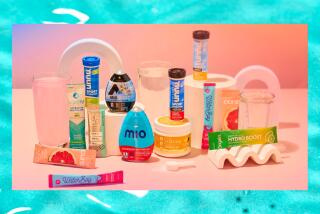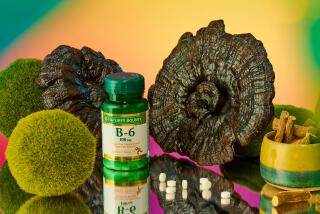Lightning in a Can
- Share via
The governing principle of this column is to test-drive pop culture, which is to say, not just muse upon it but reach out and touch it, try it out, consume it. I offer this by way of explaining why I have just ingested a 16-ounce can of Rockstar Energy Drink--which I wouldn’t have done otherwise except at gunpoint--and why now I don’t feel so wonderful.
Rockstar is loaded with B vitamins as well as compounds purported to increase energy and mental acuity, such as taurine, milk thistle and ginkgo biloba. It also contains what feels like a cup and a half of pharmaceutical caffeine in a lightly carbonated beverage that looks like mare’s urine and tastes like Dristan. My hands are shaking. My shirt is sticking to my back. It feels like neon ants are crawling around my skull. I am seriously concerned my navel is going to explode.
It must be working.
Energy drinks are the dotcoms of the beverage business. Popularized by an Austrian gentleman named Dietrich Mateschitz, who founded the Red Bull company in 1984, energy drinks have grown into a multibillion-dollar market worldwide. In the U.S. the segment is exploding like my navel. Energy drink sales are expected to increase 50% this year, approaching $1.5 billion wholesale, according to the Beverage Marketing Corp.
Red Bull--in its chic, 250-milliliter cans--controls more than half the market, but dozens of would-be matadors enter the arena each year, attracted by the extreme profitability of the segment. These beverages cost little more than soda to produce and sell for $3 and $4 a can.
What is emerging is a fascinating sociological mosaic of micro-marketed energy drinks, an array so comprehensive it’s like putting all of American pop culture in a convenience store cooler. Among my favorites: Kabbalah Energy Drink (also available in mystic sugar-free); Crunk!!!; Pimpjuice; Happy Bunny Spaz Juice (for the hard-to-reach sorority girl demo); Jones Whoop Ass Energy Drink; Orange County Choppers; Club America (directed at Latino soccer fans); Firefighter Brand EMS Strong; and Raw Dawg, which contains horny goat weed, an “herb” that’s an alleged aphrodisiac.
Speaking of herb, coming soon is an “energized soft drink” called Bong Water. This will, of course, lead to the most unlikely sentences ever uttered in English, such as: “This Bong Water tastes good,” or “Don’t bogart the Bong Water.”
Toby McBride, CEO of Bad Boy Beverage Co., wants to assure the public that, “We don’t endorse drugs and alcohol.” Good to know.
From here there are many directions to go, and considering the frog-on-a-hotplate condition of my brain, I want to go in all of them. What are the metabolic effects of compounds such as taurine, glucuronolactone, L-carnitine and yohimbe extract? According to John Craven, editor of bevnet.com, a beverage industry information resource, nobody really knows, and your government, for the most part, doesn’t want to know. “The industry is largely unregulated,” Craven says. “As far as soft drinks are concerned, there’s no process for getting them tested and approved.”
In part because of its high levels of caffeine, Red Bull is banned in France and Denmark, which only goes to show caffeine works. “There’s no science whatsoever to this stuff,” says Craven. “You take sugar and caffeine in large quantities and you get energy. All that other stuff is urban legend.”
You may wonder why these drinks taste so awful. Apparently, awful is the point. “Not tasting great might have the potential of helping the product,” says Gary Hemphill of the Beverage Marketing Corp. “That it has this medicinal quality kind of underlines why you’re consuming the product, because it provides energy.”
For me, the most alarming development is . . . no, not Steven Seagal’s energy drink, though that was a good guess . . . but alcoholic energy drinks, “malternatives” such as Anheuser-Busch’s Tilt and B-to-the-E (the “E” is in the superscript of exponential function). The very last thing this country needs is drunken frat boys with insomnia. I predict a pandemic of drunk dialing.
The larger question remains: Why are we so sleepy? Between Starbucks, Ritalin, soda and crystal meth, we are probably the most jagged-out, overstimulated society in human history. Next to us, leaf-chewing Bolivian coca growers seem positively mellow.
This one is easy. Because we don’t sleep. Most American adults don’t get eight hours a night, and most children don’t get the 10 to 12 hours they need, according to Dr. Susan Sprau, a clinical sleep disorder specialist at Santa Monica-UCLA Medical Center. You can blame cable TV’s irresistible late-night offerings or the round-the-clock rhythm of international business. You can blame noise and light pollution, which rob the night of its sedative tranquility. You can blame Edison.
“All of this tendency to sleeplessness can sort of be associated with the invention of the lightbulb,” says Dr. Sprau.
Instead of pouring all this electrified Kool-Aid down our throats, what we really need, it seems, is a good long nap. And I’m going to take one, too, as soon as I finish ironing the sheets and I polish the silver.
More to Read
Eat your way across L.A.
Get our weekly Tasting Notes newsletter for reviews, news and more.
You may occasionally receive promotional content from the Los Angeles Times.










